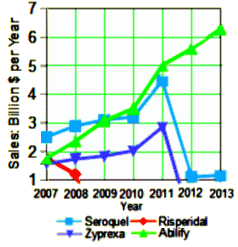In Academic·Industrial·Complex II… I was implying that the $700,000 spent on the study of Seroquel XR® in Borderline patients was a waste of money, but another way of looking at that is that their various trials of Seroquel XR® were overall worth it, because Seroquel® stayed in the Blockbuster range even after the patent expired thanks to Seroquel XR®. That’s an easy mistake to make –  to forget how much money is involved in the commerce of these drugs. Abilify® is currently involved in a similar patent extension scheme, and Johanna Ryan has a first-person blog on RxISK about the pressure to take Abilify®. Even in this era when the pharmaceutical industry has all but abandoned CNS drug development and their patent protections are disappearing, we still feel the rumblings of the now passed golden era of psychopharmacology. The KOL class in academic psychiatry is still playing the only tune they’ve known. And that far right point on the Abilify® chart [on the right] represents the number one best selling drug in the US. The Academic·Industrial·Complex is still very much a major player.
to forget how much money is involved in the commerce of these drugs. Abilify® is currently involved in a similar patent extension scheme, and Johanna Ryan has a first-person blog on RxISK about the pressure to take Abilify®. Even in this era when the pharmaceutical industry has all but abandoned CNS drug development and their patent protections are disappearing, we still feel the rumblings of the now passed golden era of psychopharmacology. The KOL class in academic psychiatry is still playing the only tune they’ve known. And that far right point on the Abilify® chart [on the right] represents the number one best selling drug in the US. The Academic·Industrial·Complex is still very much a major player.
"How many people had been imaged at the CMRR by faculty in the Department of Psychiatry in 1999? Zero. The Department of Psychiatry now images more people in CMRR than all other departments on the campus combined…""I developed an idea to focus our academics on imaging, genetics, and clinical trial research, and the rationale for that being we had one of the greatest imaging centers and that’s what the NIH wanted to do. Genetics were emerging. There hadn’t been a person imaged in CMRR, there hadn’t been a blood drawn for genotyping in the department, and I said – We have to get going in these areas. Both of those areas, I thought, could interact with doing very good clinical trial studies…"
"So, like Dr. [David] Mrazek at Mayo says – "Let’s draw your blood and find out what’s going on in your serotonin or your transporter genes or your metabolic genes and that’ll help us with your treatment. The same is also true for imaging, where we’re now imaging at baseline, giving them medicine, imaging after the study is over, and seeing where does the drug act in the brain…"
"We are now 25th out of 135 medical schools, and that puts us in a good position, but we still have a ways to go. We went from 39th in 1999 to 25th now, and we tripled our NIH funds and expanded the breadth and scope of what we’re able to do. But I’m hoping we’ll be able … to take it up a notch, and move up maybe another ten spots…"
Here’s the part where I’m speculating [but for what it’s worth, I happen to believe this speculation]. In the course of too many training programs and too many fellowships, I’ve worked in or been affiliated with a number of clinical research units and their staff. They have been the most cracker-jack support staff I’ve ever had the pleasure to work with – the crème de la crème, inspired by the possibility of advancing medical science and care – loyal to the researchers as part of the team. But in an Academic·Industrial·Complex, they’re grinding out Clinical Trials that don’t have such lofty goals – "just making a buck." The researchers are less available. For example, Dr. Olson saw Dan Markingson just "four or five times" during his six month’s stint in the CAFE trial, and I don’t know that Dr. Schulz ever met him. My speculation is that the "just making a buck" attitude filters down the ranks – manifesting as a disillusioned "just going through the motions" mentality.
 But whether my speculations are true or not, Drs. Elliot and Turner have opened a window into the world of psychiatry’s Clinical Trials and the whole Academic·Industrial·Complex that goes much further than the tragic case of Dan Markingson, than the Department of Psychiatry, than the State of Minnesota. We need even more than just the Data Transparency we’re seeking. We need Transparency for the whole Clinical Trial process. While I’m personally sensitive to the problem of financing psychiatric education, an area I left reluctantly – no matter what problems the Academic·Industrial·Complex tried to fix, it didn’t justify the obvious lapses in medical ethics that arose out of the solution. Faustian contracts with the Devil rarely do…
But whether my speculations are true or not, Drs. Elliot and Turner have opened a window into the world of psychiatry’s Clinical Trials and the whole Academic·Industrial·Complex that goes much further than the tragic case of Dan Markingson, than the Department of Psychiatry, than the State of Minnesota. We need even more than just the Data Transparency we’re seeking. We need Transparency for the whole Clinical Trial process. While I’m personally sensitive to the problem of financing psychiatric education, an area I left reluctantly – no matter what problems the Academic·Industrial·Complex tried to fix, it didn’t justify the obvious lapses in medical ethics that arose out of the solution. Faustian contracts with the Devil rarely do…
And this just in:
http://blogs.wsj.com/pharmalot/2015/04/21/psychiatrists-with-ties-to-astrazeneca-resign-from-texas-hospital/?mod=WSJBlog
Look at the numbers!
Steve Lucas
Steve,
Thanks for sending that along. To be honest, I don’t see Dr. Schulz as any less culpable than these docs in going along with the notion that Seroquel XR® has any advantage – not that Seroquel® is any great shakes. I hope those two doctors will be held accountable.
They really need to look at the Seroquel issue in the armed services and the VA where it is horribly overprescribed for everything.
http://www.theamericanconservative.com/articles/the-militarys-prescription-drug-addiction/
Quote:
“Meanwhile, the drug Seroquel has been implicated in the deaths of several veterans whose families say were using the drug when they died in their sleep. Seroquel is the brand name for Quetiapine, and although it is supposed to be prescribed for schizophrenia and bi-polar disorder, military and VA doctors have used it for years to treat stress-induced insomnia.
According to at 2010 report by the Military Times, orders for antipsychotic medications like Seroquel and Risperdal (another anti-psychotic) jumped 200 percent between 2001 and 2009, the war’s peak. In fact, before the company was successfully sued (for paying kickbacks to doctors in a scheme to promote Seroquel for uses not approved by the FDA, otherwise known as “off label”), drug-maker AstraZeneca sold $340 million worth of it to the Armed Forces. Some 54,581 prescriptions for Seroquel were written for active duty servicemembers in 2011 alone—the vast majority as a sleep aid.”